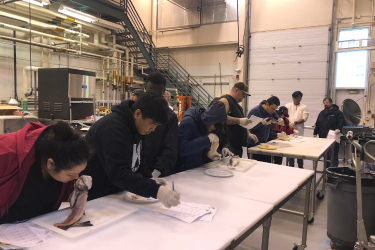The harvest of brown shrimp in the western Gulf of Mexico is expected to be 44.2 million pounds, which is above the predicted value for the last two years yet below the historical 56-year average of 56.2 million pounds, according to NOAA’s annual forecast. The prediction covers the period from July 2017 through June 2018 for state and federal waters off Louisiana and federal waters off Texas.
However, sustained high catch rates and size composition in mid-June (the end of our monitoring survey) indicate continued strong recruitment. Moreover, the 2017 Environmental Model showed favorable conditions in the bay system and predicts above average production for Texas offshore waters.
Texas and Louisiana experienced a mild winter along with record high temperatures documented in spring. Rainfall and salinity throughout Galveston Bay this year has been near the historical average. Moderate salinities combined with strong, consistent southerly winds have increased available nursery area and allowed for the greater distribution of juvenile shrimp.
NOAA scientists make the annual prediction of brown shrimp catches based on monitoring of juvenile brown shrimp abundance, growth estimates and environmental indicators. They predict shrimp catches for state and federal waters off Louisiana from west of the Mississippi River to the Texas-Louisiana border to be approximately 21.7 million pounds this season. The Texas portion of the catch is predicted to be 22.5 million pounds.
Sixty percent of the shrimp harvested in the U.S. comes from the Gulf of Mexico, especially Texas and Louisiana. Total domestic shrimp harvest brought in $488.3 million in 2015.
Young brown shrimp begin entering estuaries in Texas and western Louisiana in mid-February and continue through July, with peak recruitment occurring from February through early April.
A wide array of environmental and biological factors affects the fate of young shrimp entering the estuaries. Three environmental variables: temperature, salinity, and tidal height, have been correlated with subsequent shrimp production.
Juvenile brown shrimp abundance and growth estimates are obtained by monitoring the inshore commercial shrimp fisheries in Texas and the inshore and nearshore fisheries in Louisiana. Data for these forecasts are obtained from NOAA Fisheries Galveston Laboratory, NOAA port agents, NOAA’s National Climatic Data and Weather Centers, Texas Parks and Wildlife Department, U.S. Army Corps of Engineers, and the commercial shrimp industry.
NOAA’s mission is to understand and predict changes in the Earth’s environment, from the depths of the ocean to the surface of the sun, and to conserve and manage our coastal and marine resources.


